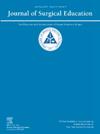Robotic Surgery Training During General Surgery Residency: A National Survey Study
IF 2.1
3区 医学
Q1 EDUCATION, SCIENTIFIC DISCIPLINES
引用次数: 0
Abstract
Purpose
To characterize current exposure to robotic surgery during United States general surgery residency and determine how specific training elements impact graduates’ incorporation of robotics in early practice.
Methods
A cross-sectional, anonymous, web-based survey was sent to recent general surgery graduates between August 2024 and January 2025. The survey underwent pilot testing before distribution. Items addressed demographics, availability and use of a structured robotic curriculum, simulator access, perceived console autonomy, and present operative practice. Counts of resident and fellow Equivalency Certificates (2020-2023) were obtained from Intuitive Surgical to contextualize trends. Descriptive statistics were performed for the full cohort. Univariate tests compared graduates who do and do not use robotics as attendings; p < 0.05 denoted significance.
Results
Seventy-six graduates from 16 programs responded (74% attendings, 61% male). Fifty-four percent reported a formal robotic curriculum, and 66% had the opportunity to obtain an Intuitive Equivalency Certificate. Curriculum presence, Intuitive Equivalency Certificate availability, robotic emphasis, robotic exposure, autonomy in robotic cases, and perceived training level increased by graduation year. However, only 37% reported high autonomy in robotic cases overall, versus 89% and 84% for open and laparoscopic cases, respectively. Intuitive Equivalency Certificates increased more than 6-fold from 133 (2020) to 822 (2023). Among the 56 practicing attendings, 59% use robotics. Post graduate adoption was more common among males (69% versus 40%, p = 0.032), minimally invasive/colorectal/oncologic surgeons (p = 0.003), graduates rating their robotic skill “advanced/expert” (89% versus 53%, p = 0.046), and those in teaching hospitals (p = 0.017).
Conclusions
Robotic training is expanding in general surgery residency, yet perceived autonomy remains variable. The discrepancy in autonomy across approaches and the association between gender and post graduate robotic use highlight potential gaps in training that warrant further investigation.
普通外科住院医师期间的机器人手术培训:一项全国性调查研究。
目的:描述目前在美国普外科住院医师中接触机器人手术的情况,并确定具体的培训要素如何影响毕业生在早期实践中结合机器人技术。方法:在2024年8月至2025年1月期间,对最近的普外科毕业生进行了一项横断面、匿名、基于网络的调查。该调查在分发前进行了试点测试。项目涉及人口统计,结构化机器人课程的可用性和使用,模拟器访问,感知控制台自主性和当前操作实践。从Intuitive Surgical获得2020-2023年住院医师和同事等效证书的计数,以了解趋势。对整个队列进行描述性统计。单变量测试比较了使用和不使用机器人的毕业生作为主治医生;p 结果:来自16个专业的76名毕业生(74%的主治医师,61%的男性)做出了回应。54%的人报告了正式的机器人课程,66%的人有机会获得直觉等效证书。课程的存在、直觉等效证书的可用性、机器人的重要性、机器人的暴露、机器人案例中的自主性,以及随着毕业年份的增加而增加的感知培训水平。然而,总体而言,只有37%的人表示机器人手术具有高度自主性,而开放手术和腹腔镜手术的自主权分别为89%和84%。直观等效证书从133个(2020年)增加到822个(2023年),增加了6倍多。在56名执业主治医生中,59%的人使用机器人。研究生在男性(69%对40%,p = 0.032)、微创/结直肠/肿瘤外科医生(p = 0.003)、毕业生认为自己的机器人技能“高级/专家”(89%对53%,p = 0.046)和教学医院的毕业生(p = 0.017)中采用机器人的比例更高。结论:机器人训练在普外科住院医师中正在扩大,但感知到的自主性仍然是可变的。不同方法在自主性上的差异,以及性别和研究生机器人使用之间的联系,突出了培训中潜在的差距,值得进一步研究。
本文章由计算机程序翻译,如有差异,请以英文原文为准。
求助全文
约1分钟内获得全文
求助全文
来源期刊

Journal of Surgical Education
EDUCATION, SCIENTIFIC DISCIPLINES-SURGERY
CiteScore
5.60
自引率
10.30%
发文量
261
审稿时长
48 days
期刊介绍:
The Journal of Surgical Education (JSE) is dedicated to advancing the field of surgical education through original research. The journal publishes research articles in all surgical disciplines on topics relative to the education of surgical students, residents, and fellows, as well as practicing surgeons. Our readers look to JSE for timely, innovative research findings from the international surgical education community. As the official journal of the Association of Program Directors in Surgery (APDS), JSE publishes the proceedings of the annual APDS meeting held during Surgery Education Week.
 求助内容:
求助内容: 应助结果提醒方式:
应助结果提醒方式:


